Bennemann K.H., Ketterson J.B. Superconductivity: Volume 1: Conventional and Unconventional Superconductors; Volume 2: Novel Superconductors
Подождите немного. Документ загружается.

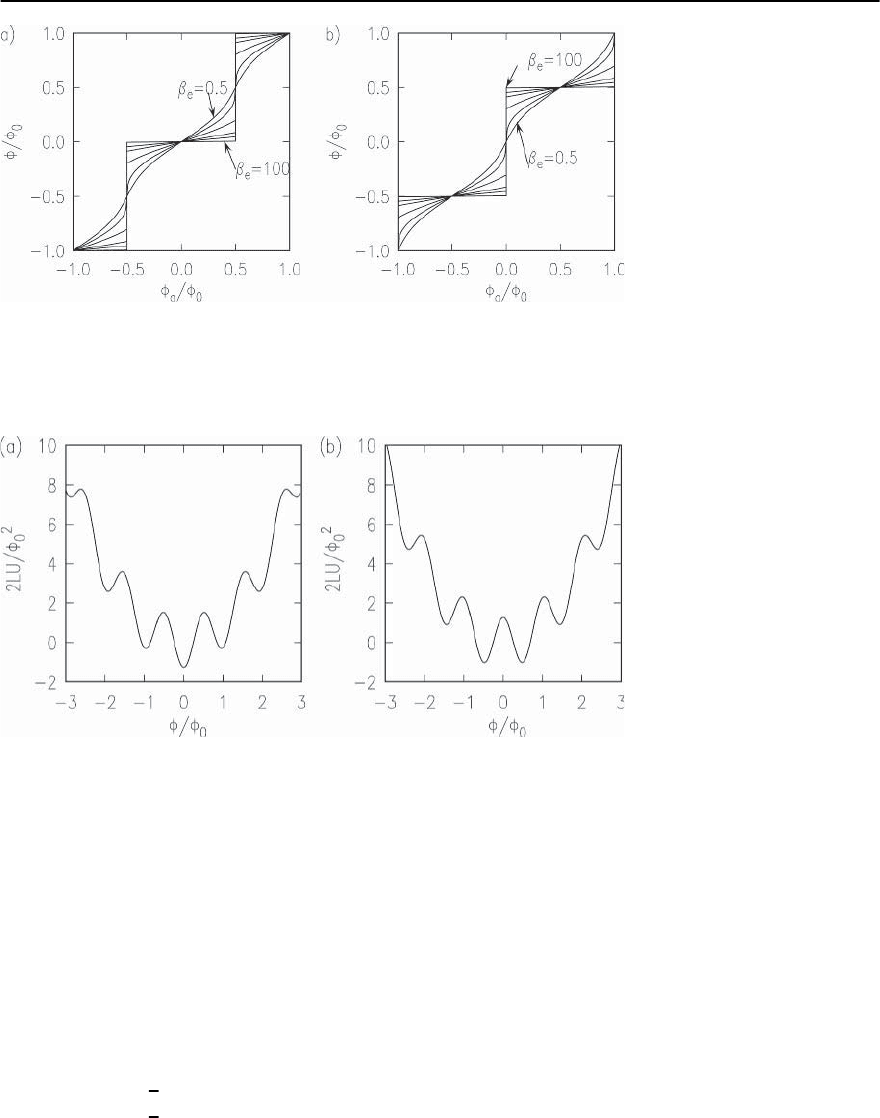
878 C. C. Tsuei and J.R. Kirtley
Fig. 16.3. Minimum energy solution of (16.17) for the total flux ¥ /¥
0
as a function of the externally applied flux ¥
a
/¥
0
for
a0-ring(a)and -ring (b), for ˇ
e
=2 LI
c
/¥
0
= 0.5,1,2,5,10,and 100. For small applied fields and ˇ
e
< 1 the shielding
currents oppose the applied flux for the 0-ring (diamagnetic shielding) and are aligned with the applied flux for the
-ring (paramagnetic shielding). For ˇ
e
> 1the-ring has spontaneous magnetization with the same sign as small
externally applied fields, approaching total flux ¥ = ¥
0
/2for¥
a
=0asˇ
e
becomes large
Fig. 16.4. Free energy U of a su-
perconducting ring with a sin-
glejunctionin(a)a0-ring,
or (b)a -ring configuration,
with zero external applied field
(16.17), as a function of the
total flux ¥ in the ring. Here
ˇ
e
=2LI
c
/¥
0
=5
whered is the spacing between superconductors,and
J
1
is the supercurrent density in the junction, and Ÿ
is 0 for the 0-section, and for the -section. As
discussed above, the assignment of 0 or for the in-
trinsic phase shift of a particular section of the junc-
tion is arbitrary: identical results are obtained if the
assignments are reversed. (r
i
) is related to the cur-
rent flowing through the junction by the Josephson
relation j
s
= j
ci
sin((r
i
)+Ÿ(r
i
)).
The lowest energy solution of (16.19) for a 0–0-
junction is (r
i
) = 0: there is no spontaneous mag-
netization.For a 0 − -junction with width W much
wider than the
Ji
s, the solution of (16.19) is [102]
(x)=4tan
−1
[(
√
2−1)e
r
i
/
Ji
] r
i
< 0 ,
4tan
−1
[(
√
2+1)e
r
i
/
Ji
]− r
i
> 0 .
(16.20)
This is the equation fora Josephson vortex with ¥
0
/2
total flux. If the width of the junction is compara-
ble to the Josephson penetration depth, the solu-
tion of (16.19) is more difficult [100]. Numerical re-
sults [103] for the total spontaneous flux for a sym-
metric 0− junction(equal widths of intrinsic0 and
phase shifts) as a function of the reduced width
W/2
j
are shown as the open symbols in Fig.16.5.As
discussed below, the spontaneous magnetization in
frustrated rings and junctions has been directly ob-
served by magnetic imaging using scanning SQUID
microscopes.
One can also test for frustration in a supercon-
ducting loop by connecting leads to it, and measur-
ing the superconducting critical current through the
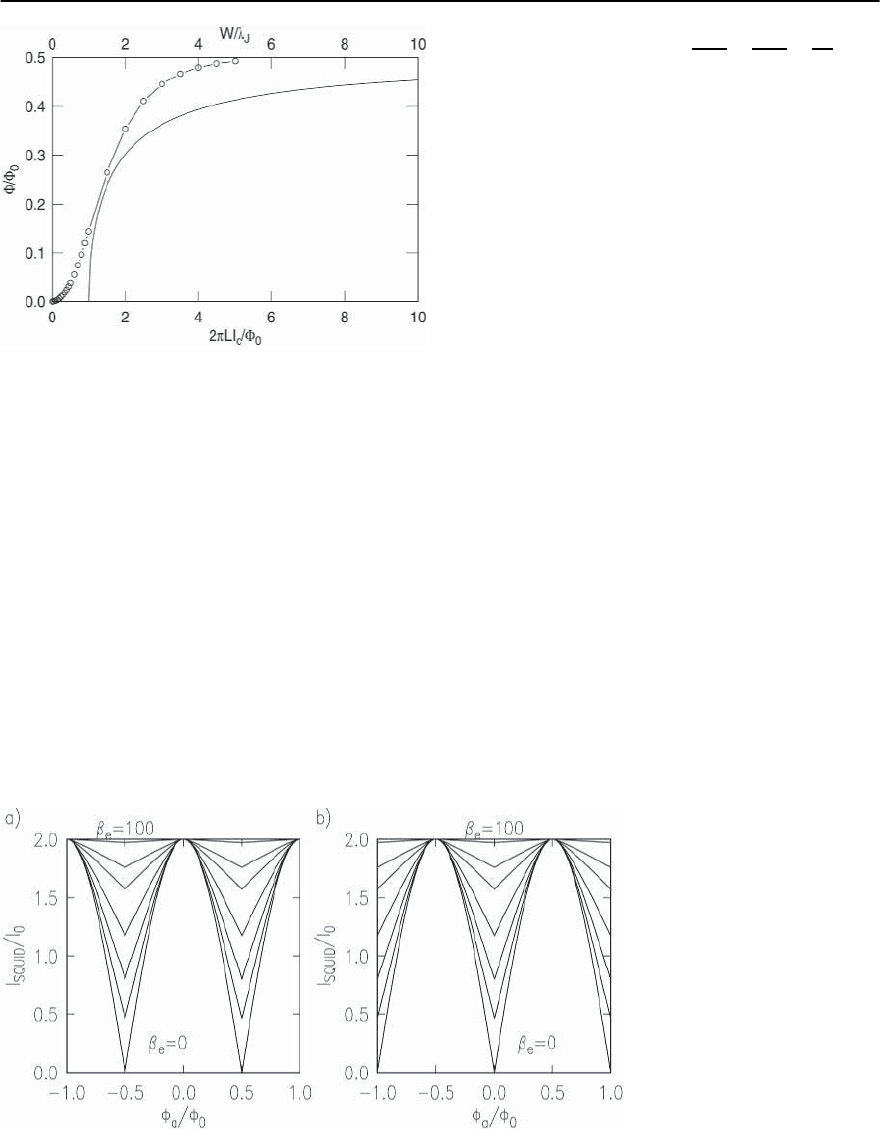
16 Phase-Sensitive Tests of Pairing Symmetry in Cuprate Superconductors 879
Fig. 16.5. Total spontaneous flux ¥ /¥
0
,forafrustratedsu-
perconducting ring in zero applied flux ¥
a
,asafunctionof
ˇ
e
=2LI
c
/¥
0
(solid line, lower scale),andforasymmetric
0− junction as a function of W/2
J
(open circles, upper
scale), where W is the total width of the junction,and
J
is
the Josephson penetration depth
loop as a function of the applied flux ¥
a
.Consider
a closed ring of superconductor interrupted by two
Josephson weak links labeled a and b.Themeasured
critical current of the SQUID is the maximum of
I
s
=I
a
sin
a
+I
b
sin
b
, (16.21)
where I
a
(I
b
)and
a
(
b
) are the critical currents and
phases of the a (b)-junctions,respectively. This max-
imum must be calculated subject to the constraint
that the phase be single valued:
2n=
a
−
b
+ Ÿ +2
I
a
L
a
¥
0
−
I
b
L
b
¥
0
+
¥
a
¥
0
,
(16.22)
where L
a
and L
b
are the effective self-inductances
of the two arms of the ring, and Ÿ =0or for
a0-ringora-ring, respectively. The dependence
of the SQUID critical current I
SQUID
vs. applied flux
¥
a
is plotted in Fig. 16.6 for a number of different
ˇ
e
=2LI
c
/¥
0
values. For these plots we have as-
sumed I
0
= I
a
= I
b
,andL
a
= L
b
. Asymmetries in
the junctioncriticalcurrent or arm inductances pro-
duce phase shifts in the interference patterns, and
reductions in the modulation depths. The modula-
tion depth decreases as the ˇ
e
increases.
For junctions with uniform Josephson current
density, and in the “short” junction limit where
the junction size is much smaller than the Joseph-
son penetration depth, the critical current should
follow the standard Fraunhofer pattern I
c
(¥ )=
I
0
|sin(¥/¥
0
)/(¥/¥
0
)| as a function of the flux
¥ threading the junction, for an unfrustrated (0–
0) junction. This pattern has a maximum in the
critical current at zero applied field (see Fig. 16.7).
In contrast, a “short” frustrated (0 − )junc-
tion should show the interference pattern I
c
(¥ )=
I
0
|sin
2
(¥/2¥
0
)/(¥/2¥
0
)|,withaminimumat
zero applied flux. As can be seen from Fig. 16.7, as
the ratio of the junction width to the Josephson pen-
etration depth gets larger, the modulation depth of
these interference patterns decrease. Further, inho-
mogeneities in the junction current densities will
Fig. 16.6. Dependence of the
total critical current I
SQUID
through a symmetric conven-
tional (a)andfrustrated(b)
SQUID, normalized by the sin-
gle junction critical current I
0
,
as a function of the normal-
ized applied flux ¥
a
/¥
0
thread-
ing through the SQUID ring,
for values of ˇ
e
=2 LI
c
/¥
0
=
0, 0.5, 1, 2, 5, 10, and 100
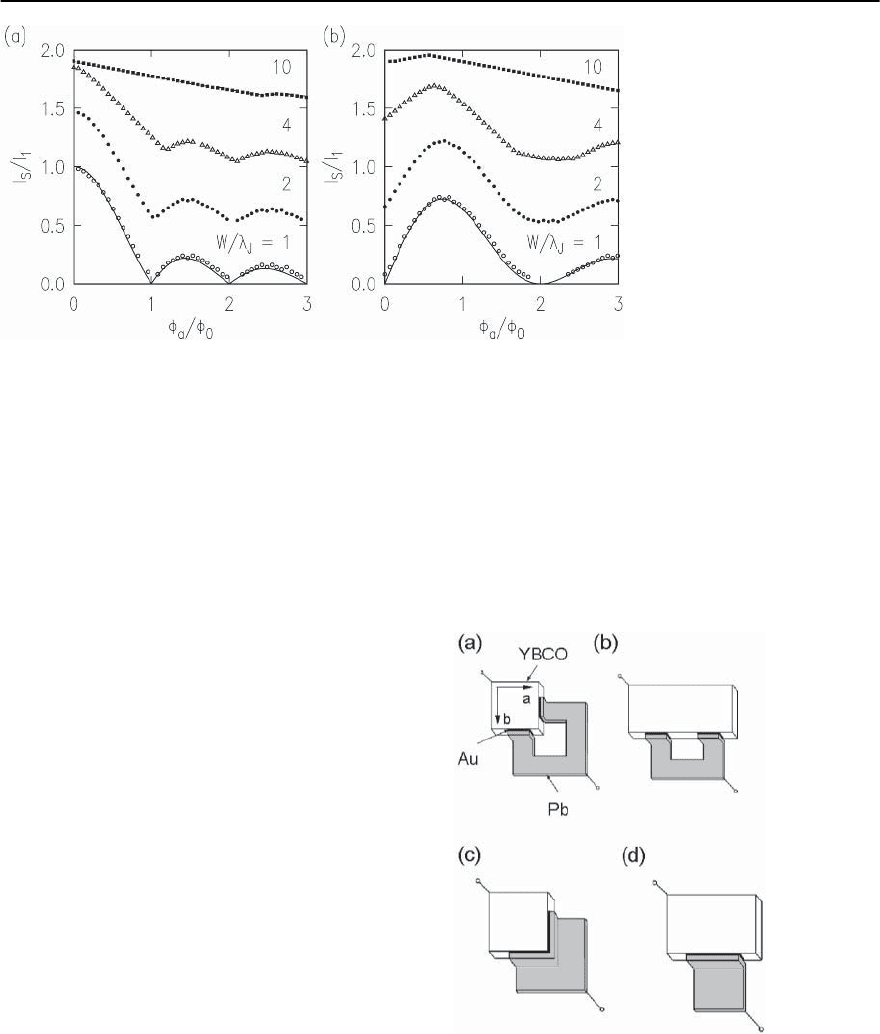
880 C. C. Tsuei and J.R. Kirtley
Fig. 16.7. Dependence of the total critical current I
s
through a single symmetric conventional (0–0, (a) and a frustrated
(0 − ,(b) junction, normalized by the single (0–0) junction critical current I
0
, as a function of the normalized applied
flux ¥
a
/¥
0
threading through the junction, for values W /
J
=of0(solid lines), 1,2,4, and 10 (symbols), where W is the
junction width, and
J
is the Josephson penetration depth. Each successive curve has been offset by 0.5 units for clarity
modify the interference patterns, in general further
reducing the modulation depths.
Toconcludethis section,wenotethatthere are two
ways to test for frustration in superconductingloops:
by measuring the spontaneous magnetization at zero
applied magnetic flux, or by measuring the critical
current through the loop (or junction) as a function
of applied magnetic field. These two types of test are
complementary, in the sense that the spontaneous
magnetization is largest when the ring inductance or
junction width is big, but the magnetic interference
patterns are the most clear when the ring inductance
or junction width is small.
16.3 Phase-Sensitive Tests: Experiments
16.3.1 SQUID Interferometry
Wollman et al. reported the results of the first phase-
sensitive test of pairing symmetry in a controlled
configuration [104] by measuring the quantum in-
terference effects in a YBCO-Pb dc-SQUID, in the
“corner SQUID” geometry, proposed independently
by Sigrist and Rice [82]. (Fig. 16.8(a)). Josephson
weak links were made between Pb thin films and
two orthogonally oriented ac (or bc ) plane faces of
single crystals of YBCO. If YBCO is a d-wave super-
conductor, there should be a -phase shift between
weak links on adjacent faces of the crystal. Annett et
al. [5] have argued that it is plausible that the pair
transfer matrix T
k,l
(16.6) is strongly peaked in the
forward direction for both SNS and tunneling weak
Fig. 16.8. Experimental geometry used for the experiments
of Wollman et al. [104,105].(a) Corner SQUID configura-
tion, (b) edge SQUID configuration, (c) corner junction,
and (d)edgejunction
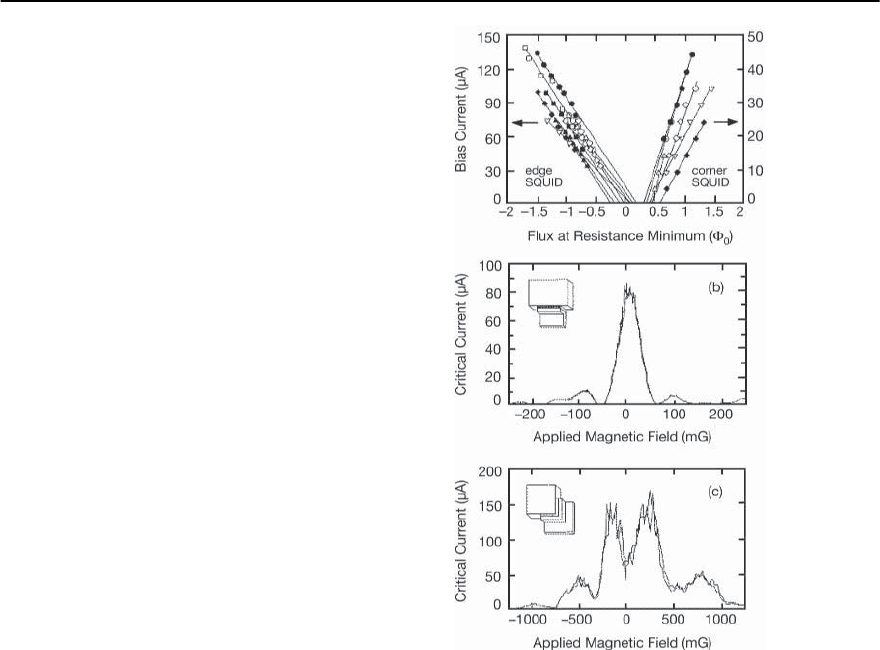
16 Phase-Sensitive Tests of Pairing Symmetry in Cuprate Superconductors 881
links, making the Sigrist–Rice clean relation (16.9)
applicable. Wollman et al. [104] tested for this phase
shift by measuring the SQUID critical current as a
function of ¥
a
, the externally applied magnetic flux
through the SQUID,as described in the discussion of
Fig. 16.6. In the experiments of Wollman et al. [104],
the junction I
c
’s and L’s were not necessarily bal-
anced, leading to shifts in the I
c
vs ¥
a
characteristics.
Noise rounding of the current-voltage characteris-
tics of these SQUIDs made it possible for Wollman et
al. to do these measurements at several values of the
d.c. applied current through the SQUID, and correct
for these self-field effects. This was done by plotting
the phase shift as a function of d.c. current through
the SQUID, and then extrapolating to zero current
to infer the intrinsic phase shift. The intercepts for
the “corner SQUIDs” varied between 0.3 and 0.6 ¥
0
.
When these experiments were repeated with “edge
SQUIDs”,Fig.16.8(b),withtwo junctionsonthesame
ac (or bc ) face of the crystal. the intercepts centered
around zero (Fig. 16.9(a)).
There were a number of complicating factors in
the interpretation of the SQUID experimentsof Woll-
man et al. [104]. The issue of twinning will be dis-
cussed in detail in Sect. 16.3.7. Briefly, if the pair or-
der parameter phase of a d-wave superconductor is
locked to the crystal axes (for example,with the pos-
itive lobe always pointing along the a direction),the
sign in a particular ab planedirectionwouldbeex-
pected to alternate from twin to twin, washing out
the phase–sensitive effects described here. This does
not happen,which indicates that the d-component of
the order parameter locks across twin boundaries.
Other issues in the interpretation of these experi-
ments were the linear extrapolation in d.c. current
used [106, 107], the comparison of sample geome-
tries with corners with those without corners [108],
and the effects of flux trapping.However,subsequent
phase-sensitive experiments without these problems
[87,109] have shown that these issues were not se-
rious enough to affect the qualitative conclusion of
predominantly d-wave orbital pairing symmetry in
YBCO made by Wollman et al..
BrawnerandOtt [110] performedasecondSQUID
interference experiment on single crystals of YBCO.
In contrast to the Wollman et al. experiments [104],
Fig. 16.9. Summary of the experimental results of Wollman
et al. [104,105].(a) Extrapolation of the measured SQUID
resistance minimum vs flux to zero bias current for a cor-
ner SQUID and an edge SQUID on the same crystal. Each
curve represents a different cooldown of the sample. (b)
Measured critical current vs applied magnetic field for an
“edge” junction and (c) a“corner” junction
instead of using evaporated thin films for the second
electrode, they made a SQUID with two bulk point
contact junctions of niobium, producing Josephson
weak links on adjoining orthogonal faces of an un-
twinned YBCO single crystal. Two all niobium con-
trol SQUIDs on either side of the sample SQUID were
used to measure the relative phase shifts. The junc-
tion critical currents and the inductances of the two
arms of the SQUIDs were asymmetric, so that as with
the Wollman et al.[104] experiments, corrections for
self-field effects had to be made. To do this Brawner
and Ott [110] measured the dynamic resistance of
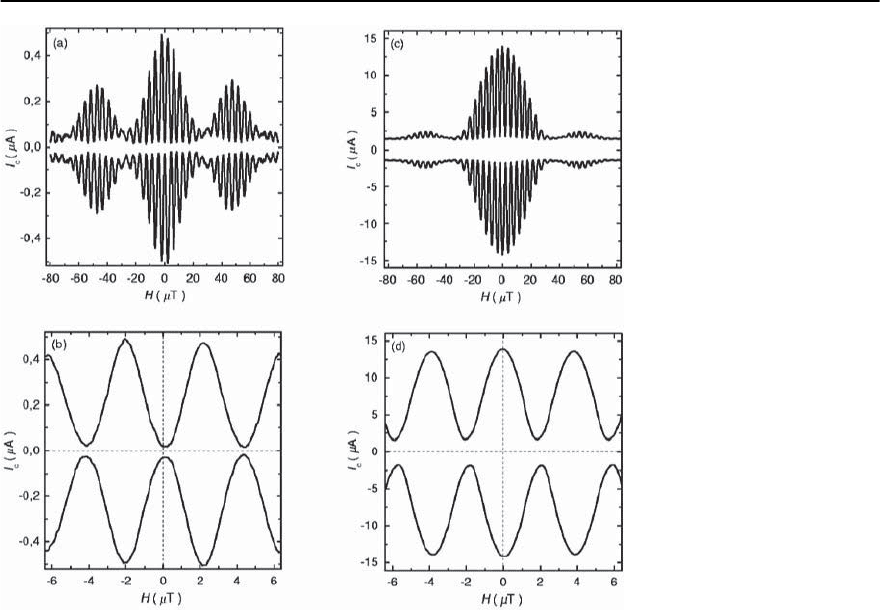
882 C. C. Tsuei and J.R. Kirtley
Fig. 16.10. Magnetic interfer-
ence patterns for a thin film,
spatially distributed junctions,
low inductance -SQUID (a,
b),anda0-SQUID(c, d). The
characteristics show a nearly
ideal interference pattern over
a small field range (b, d), with
ashiftof¥
0
/2, as expected. An
interference envelope due to the
finite size of the junctions is ap-
parent over a larger field range
(a, c). From [109]
their SQUIDs as a function of d.c. applied current
and extrapolated their results to zero current. They
found consistent phase shifts between their control
and sample SQUIDs of 160 ±20
◦
, consistent with the
180
◦
degree phase shift expected between the normal
components to the order parameter on the two faces
of the YBCO crystal for a d
x
2
−y
2
superconductor.
Schulz et al. [109] produced all high-T
c
0and-
ring SQUIDs based on the spatially distributed junc-
tions,low inductanceSQUID design of Chesca [111],
using YBCO thin films epitaxially grown on bicrys-
tal and tetracrystal (e.g. Fig. 16.22(a)) SrTiO
3
sub-
strates. These devices, which had the advantages of
very small sample volumes (so that flux trapping was
not an issue) and small I
c
L products (so that self–
field effects were negligible), showed nearly ideal de-
pendences of the critical current on applied field,
with a minimum at zero applied field for the -ring
SQUID, as expected for a d-wave superconductor in
the tetracrystal geometry used (see Fig. 16.10).
16.3.2 Single Josephson Junction Modulation
In addition to measurements in a SQUID geometry,
Wollman et al. also performed phase-sensitive mea-
surements in a single junction geometry [104, 105]
(Figs. 16.8(c) and (d)). This geometry had the ad-
vantage of being less sensitive to the effects of flux
trapping and sample asymmetry. It is expected that
the critical current in the single junction geome-
try should have the interference patterns shown in
Fig. 16.7 for junctions with uniform Josephson cur-
rent density. Wollman et al. [104,105] reported con-
sistent results of a maximum in the interference pat-
tern for “edge” junctions(Fig. 16.9(b)), and a mini-
mum for “corner” junctions(Fig. 16.9(c)), consistent
with d
x
2
−y
2
symmetry. Similar evidence for d-wave
pairing was also reported by Iguchi and Wen [112].
As can be seen from a comparison of Figs. 16.9
and 16.7, the interference patterns reported by Woll-
man et al. [104, 104] did not agree closely with the

16 Phase-Sensitive Tests of Pairing Symmetry in Cuprate Superconductors 883
ideal expressions.They attributed this discrepancy to
asymmetries in the current densities in the junctions
and flux trapping, and reported good agreement
with modeling including these effects [6]. However,
qualitatively similar interference patterns have been
reported for square [113] and annular [114–116]
Josephson junctions with a single vortex trapped in
them. The Illinois group reported that symmetric
interference patterns, with minima at zero applied
field, such as they observe, cannot be reproduced in
modeling with an s-wavesuperconductorin their ge-
ometry. In addition, it seems unlikely that magnetic
flux consistently trappedin the Illinois“corner”junc-
tions in sucha way as to mimic d-wave superconduc-
tivity.
In an experiment analogousto the Illinois“corner”
single junction experiments, Miller et al. [117] used
frustrated thin-film tricrystal samples to probe the
pairing symmetry in YBCO. The tricrystal geometry
will be discussed in detail in the next section. Miller
et al. measured the dependence on magnetic field
of the critical current of a 3m wide micro bridge
spanning the tricrystal point. They found a mini-
mum in the critical current at zero applied field, as
expected for a d-wave superconductor in this geom-
etry, in the “short junction” limit (where the width
W of the bridge is much shorter than the Josephson
penetration depth
J
[100] (seeFig.16.7).They found
that junctions in an unfrustrated geometry, or wide
junctions (L
J
) in a frustrated geometry, showed
maxima in their critical currents at zero magnetic
fields [102], as expected.
16.3.3 Tricrystal Magnetometry
Controlled-Orientation Multi-Crystals
In this class of experiments, a multiple-junctionring
is made, consisting of deliberately oriented cuprate
crystals that define the direction of the pair wave-
function. The presence or absence of the half-integer
flux quantum effect in such samples as a function
of the tricrystal geometry is used as an unambigu-
ous signature for a certain pairing symmetry. In the
first such phase-sensitive experiment of this type
for testing the d-wave pairing symmetry, tricrys-
tal (100) SrTiO
3
substrates with controlled orien-
tations were designed and fabricated (Fig. 16.11).
The c-axis oriented epitaxial cuprate films were de-
posited and photolithographically patterned into
rings (Fig. 16.12). The ring centered at the tricrystal
meetingpoint isinterruptedbythreegrainboundary
Josephson junctions.In accordance with an assumed
pair state, the three-junction ring is expected to ex-
hibit conventional integer flux quantization (0-ring)
or the half-integer flux quantum effect (-ring) de-
pending on the misorientation angles ˛
12
, ˛
31
,and
the angle ˇ between the grain boundaries 23 and
31 as defined in Fig. 16.11(a). For testing of d-wave
pairing symmetry, based on the Sigrist–Rice (clean)
formula (16.9), the three-junction ring is a 0-ring if
cos 2(˛
12
+ˇ)cos2(˛
12
−ˇ) is positive (with the con-
dition ˛
12
= /2−˛
31
assumed for simplicity), and
a -ring if cos2(˛
12
+ˇ)cos2(˛
12
−ˇ) is negative.In
Fig. 16.11(b), the tricrystal design parameters range
(˛
12
, ˇ) for -rings (which can be thought of as hav-
inganoddnumberofsignchangesintheI
c
’s) are
plotted as open area; and that for 0-rings (an even
number of sign changes) are shown in the shaded
areas.As emphasized in Sect.16.2.1, the effect of dis-
order at the junction interface must be considered
in the design of any viable phase-sensitive experi-
ment. It can be shown (16.10) [87] that in the max-
imum disorder limit the three-junction ring is a -
ring if cos(2˛
12
)cos(2˛
31
)cos(˛
12
− ˛
31
) is negative.
The design parameter space for the d-wave 0 and
-ring configuration with maximum disorder taken
into account is shown in Fig. 16.11(c).
The design parameters selected for the origi-
nal tricrystal phase-sensitive experiment [87] were
˛
12
=30
◦
, ˛
31
=60
◦
,andˇ =60
◦
(Fig. 16.12), corre-
sponding to the solid dot in Figs. 16.11(b) (the clean
limit) and 16.11(c) (the dirty limit), well within the
bounds of the d-wave -ring regime. If a cuprate
under the symmetry test is indeed a d-wave super-
conductor, such tricrystal rings should show half-
integer flux quantization, regardless of whether the
junction interface is in the clean or dirty limit. The
situationinanactualgrainboundaryjunctionof
cuprate superconductors is expected to fall some-
where in between. Tricrystal rings with design pa-
rameters located within the 0-ring regime (shaded
areas in Figs. 16.11(b) and 16.11(c)) should display
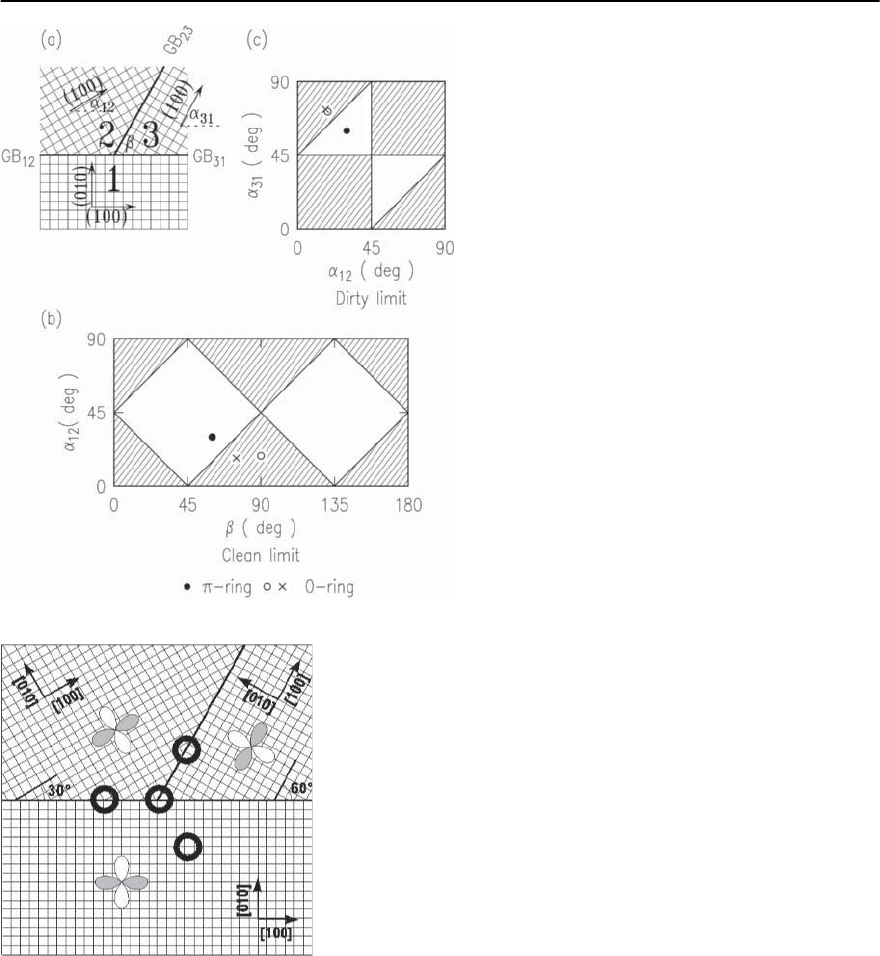
884 C. C. Tsuei and J.R. Kirtley
Fig. 16.11. Tricrystal geometry (a),regions of the design
parameters which give 0 (shaded a reas)and (open
areas) rings in the clean (b)anddirty(c) limits. The
• is the design point for the frustrated three-junction
ring samples (Fig. 16.16a). The ◦ (Fig. 16.16b) and ×
(Fig. 16.16c) are the design points for the unfrustrated
three-junction ring samples
Fig. 16.12. Experimental configuration for the -ring
tricrystal experiment of Tsuei et al. [87]. The central, three-
junction ring is a -ring, which should show half-integer
flux quantization for a d
x
2
−y
2 superconductor, and the
two-junction rings and 0-junction ring are 0-rings, which
should show integer flux quantization, independent of the
pairing symmetry
only the regular integer flux quantization, for rings
made of a d-wave superconductor. The absence of
the half-integer flux quantum effect in these three-
junction rings designed to be 0-rings represent evi-
dence for d-wave order parameter symmetry in ad-
dition to that provided by the presence of the half-
integer flux quantum effect in three-junction rings
designed to be -rings.
In the tricrystal experiment of Tsuei et al. [87],
an epitaxial YBCO film (1200 Å thick) was de-
posited using laser ablation on a tricrystal (100)
SrTiO
3
substrate, and rings (48m inner diame-
ter, 10m in width) were patterned by a standard
ion-milling photolithographic technique. In addi-
tion to the three-junction ring located at the tricrys-
tal meeting point, two two-junction rings and one
ring with no junction were also made as controls
(see Fig. 16.12). The control rings are in the 0-ring
configuration and should exhibit the standard inte-
ger flux quantization. Measurements of the critical

16 Phase-Sensitive Tests of Pairing Symmetry in Cuprate Superconductors 885
current densities of these grain boundaries, com-
bined with the estimated self-inductanceof the rings
L = 100 pH, indicated that the I
c
L product was about
100¥
0
, easily satisfying the condition I
c
L >> ¥
0
for
observing ¥ = ¥
0
/2 flux quantization (see the dis-
cussion in Sect. 16.2.2).
Magnetic Flux Imaging
The magnetic flux threading through the supercon-
ducting cuprate rings in the tricrystal experiments
was measured using a scanning SQUID microscope
(SSM) [118]. Themagnetic field sensor used is an in-
tegrated miniature SQUID magnetometer with sys-
tem noise about 2×10
−6
¥
0
/Hz
1/2
.Shown in Fig.16.13
is an SSM image of four rings of c-axis oriented
epitaxial YBCO film deposited on a tricrystal (100)
SrTiO
3
substrate three-junction YBCO ring with the
configuration shown in Fig.16.12.As presented in the
following discussion,four different waysofanalyzing
the SSM data of the type shown in Fig.16.13 have lead
to the conclusion that the magnetic flux through the
three-junction ring is indeed ¥
0
/2, while the other
rings contain no flux, providing strong evidence for
d-wave order parameter symmetry in YBCO.
Fig. 16.13. Top view of a scanning SQUID microscope im-
age of a thin-film YBCO tricrystal ring sample, cooled and
imaged in nominally zero magnetic field. The outer con-
trol rings have no flux in them; the central three-junction
ring has half of a superconducting quantum of flux spon-
taneously generated in it
The four techniques for calibrating the amount
of flux through the superconducting rings can be
briefly summarized as follows. The details can be
found in [7].
(a) Direct calculation: A given flux threading a ring
with self-inductance L induces a circulating current
I
r
= ¥
0
/L around the ring, which in turn produces
aflux¥
s
()=M()¥ /L in the SQUID pickup loop.
The calculated inductance of the rings of Fig. 16.13
is L =99± 5pH.
The mutual inductance M() between a pickup
loop tilted at an angle from the sample (x − y)
plane in the x − z plane and a circular wire of radius
R at the origin can be written as:
M()=
0
R
4
dxdy
2
0
d (16.23)
×
cos (R − y sin − x cos )−sin(z cos )
(x
2
+ y
2
+ z
2
−2xR cos −2yR sin )
3/2
,
where the integral dxdy is over the plane of the
pickup loop, and the vector specifies the displace-
ment of the pickup loop with respect to the ring in
the x–y plane.
The solid lines in Fig. 16.14a are model calcula-
tions, based on (16.23) and the pickup loop geom-
etry used in the experiment, for three cross-section
through the SSM image, assuming ¥ = ¥
0
/2. The
asymmetry in the image can be attributed to the tilt
of the pickup loop, as well as the asymmetric pickup
area from the unshielded section of the leads. A best
fit of the SSM data yields ¥ =0.57 ± 0.1¥
0
,usinga
doubling of the
2
as a criterion for assigning statis-
tical errors.
(b) Magnetic “oil drop”: The changes in the SQUID
signal as a function of applied magnetic field are
monitored as individual single flux quanta enter the
superconducting rings. A staircase pattern in the
SQUID output vs. field thus observed (see Fig. 16.14
(b)) can be used for calibration. Using the heights of
the single flux-quantum steps in Fig. 16.14(b) as a
calibration leads to values for the three-junction ring
flux of 0.46 ± 0.09¥
0
in its lowest allowed flux state.
(c)Measurements of the absolute values of the differ-
ence between the SQUID signal when the pickuploop
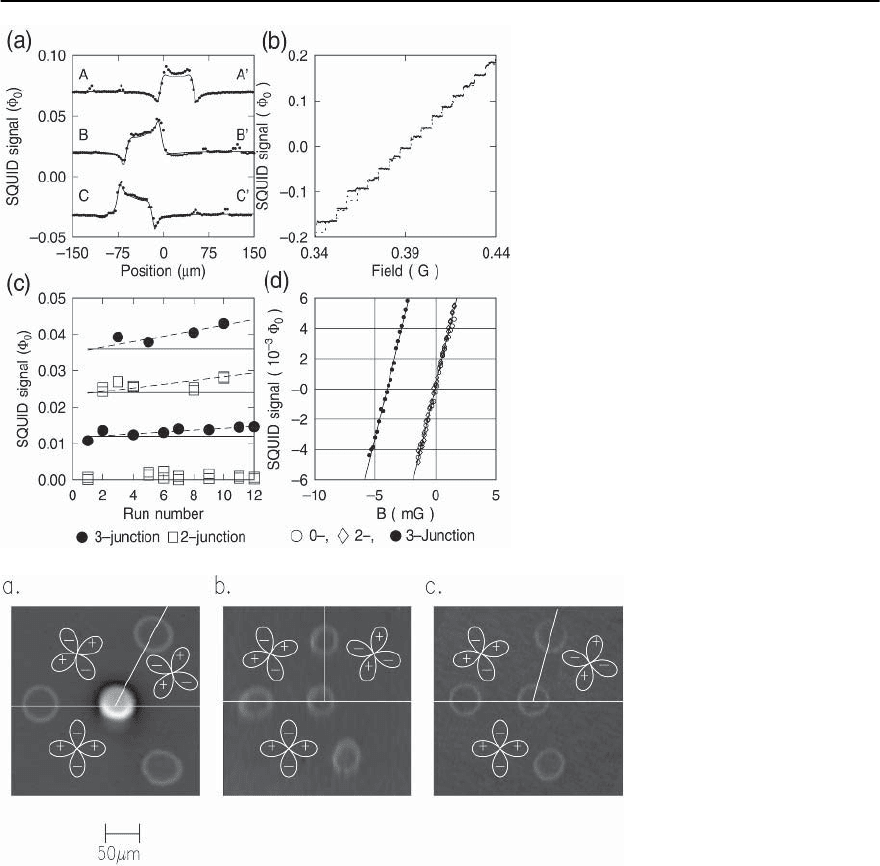
886 C. C. Tsuei and J.R. Kirtley
Fig. 16.14. Four techniques for demonstrating
the half-flux quantum effect in the tricrystal
ring samples: (a) Direct calculation, assuming
the central ring has ¥
0
/2=h/4e flux in it.
(b)ObservationofthechangeintheSQUID
signal as individual vortices enter the three-
junction ring, with the pickup loop centered
on the ring. (c) Measurements of the abso-
lute values of the pickup loop flux when it
is directly above the 0-junction ring minus
that above the two-junction (open squar es)and
three-junction (dots)rings,foranumberof cool
downs. (d) Measurements of the SQUID signal
directly above the rings, as a function of exter-
nally applied field
Fig. 16.15. (a)–(c) Three differ-
ent SrTiO
3
tricrystal geome-
tries and scanning SQUID im-
ages of YBCO ring samples fab-
ricated on these substrates to
elucidate the origin of the ob-
served half-flux quantum effect
in YBCO.Both the presence and
the absence of this effect rep-
resent strong evidence for a d-
wave pair state in YBCO
isdirectlyabovethe0-junction ringminusthatabove
the two-junction (open squares in Fig. 16.14(c))
and three-junction (dots) rings, for a number of
cooldowns of the tricrystal sample. The solid lines
are the expected values for the flux difference, cal-
culated from (16.23) as described above. The values
of the SQUID signal always fall close to (N +1/2)¥
0
for the three-junction rings, and N¥
0
for the two-
junction rings (N an integer). The upward drift in
the data as a function of increasing run number was
due to tip wear of the SQUID assembly. The dashed
lines in Fig. 16.14(c),including this correction agree
with the data.
(d) “Magnetic field titration”: The SQUID signal at
the center of a superconducting ring, relative to the
background outside the ring, for all rings in the
experiments, can be determined by using the SSM
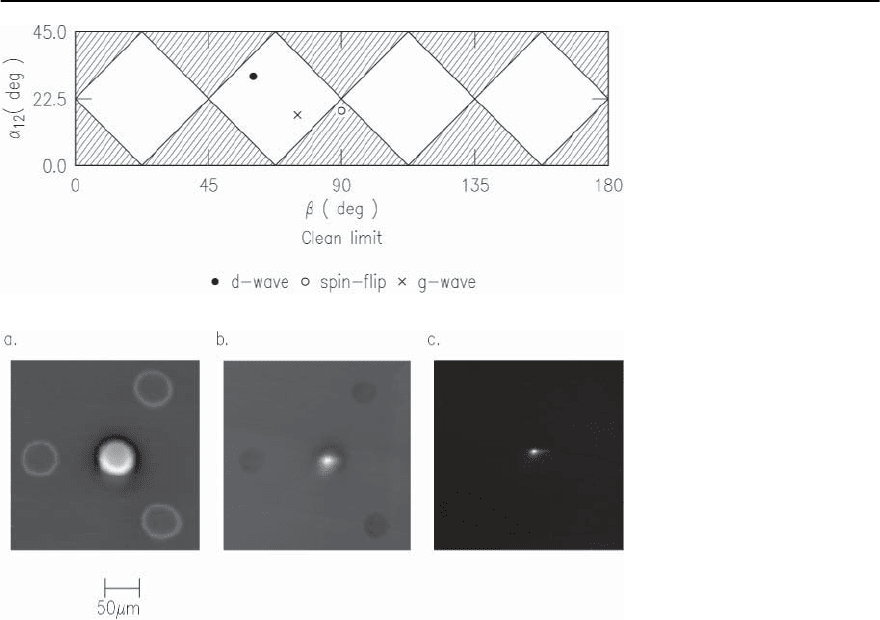
16 Phase-Sensitive Tests of Pairing Symmetry in Cuprate Superconductors 887
Fig. 16.16. Parameter space for
thepresence(open)orabsence
(shaded) of the half-integer flux
quantum effect fortricrystal ge-
ometries, for an assumed sym-
metric g-wave pairing symme-
try ∼ cos k
x
+cosk
y
.Thesolid
symbol represents the design of
Fig. 16.15(a), the open symbol
is that of Fig. 16.15(b), and the
cross is that of Fig. 16.15(c)
Fig. 16.17. (a)–(c) Scanning
SQUID microscope images of
three thin film samples of
YBCO epitaxially grown on
identical d-wavetestingtricrys-
tal substrates to show the half-
flux quantum effect is indepen-
dent of macroscopic sample ge-
ometry. In all cases there is a
half-flux quantum of total flux
spontaneously generated at the
tricrystal point, but the spa-
tial distributions of supercur-
rent are different
while varying the externally applied magnetic field
until the SQUID signal outside the ring is exactly
nullified by the screening current induced field (see
Fig.16.14(d)).The resultof such a procedure leads to
avalueof0.49±0.015¥
0
more flux threading through
the three-junction ring that the 0-junction or two-
junction rings.
On a separate note,it shouldbe mentioned that the
reasonthatthe zero-flux state of thecontrolrings(i.e.
the two-junction and 0-junction rings) are visible in
the SSM (see Fig. 16.13) is that the high sensitivity of
SSM allows it to detect very small changes in the in-
ductance of the SQUID when the pickup loop passes
over the ring, even when it contains no flux.
Shown in Fig. 16.15 are the results of a series
of tricrystal experiments with various geometrical
configurations to clarify further the nature of the
observed half-flux quantum effect. As expected, the
sample in panel (a),which had a frustrated geometry
fora d
x
2
−y
2
superconductor (˛
12
=30
◦
,˛
31
=60
◦
,ˇ =
60
◦
, see Fig. 16.11) showed half-integer flux quanti-
zation, while the samples in panels (b) (˛
12
= 108.4
◦
,
˛
13
=71.6
◦
, ˇ =90
◦
) and (c) (˛
12
= 107
◦
, ˛
13
=73
◦
,
ˇ =75
◦
) [119,120] which had 0-ring configurations
(i.e. shaded areas in Figs. 16.11(b) and 16.11(c)), did
not. The absence of the half-integer flux quantum
effect in these two tricrystal experiments has ruled
outany symmetry-independent mechanisms [89,90]
as the cause of the -phase shift. In addition, the
tricrystal shown in panel (c) rules out even-parity g-
wave pairing symmetry with order parameter vary-
ing as (cos k
x
+cosk
y
) (see Fig. 16.16).
As concluded from the discussion in Sect. 16.2.2,
half-integer flux quantization is a manifestation of
the ground state in any singly connected supercon-
ducted loop with an intrinsic phase shift of .The
observation of such an effect should be independent
of the macroscopic form that the sample takes. In-
